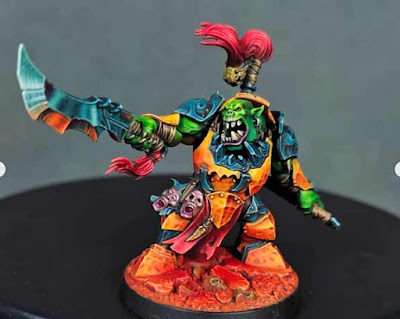*Quick Science Sidebar: Since I haven’t mentioned it before, what is a pigment anyway, and how is it different from dye? Dyes and pigments are what gives a medium its colour. A dye is a coloured chemical substance that directly bonds to a surface. Pigments, on the other hand, do not chemically bind to the material they colour. Paints made with pigment colouring require a “binder”, such as acrylic or resin polymer, that cures/dries on the applied surface.
So how are inks useful in painting miniatures? First, inks are great for painting freehand (drawing designs, letters, symbols, etc on your model - basically going outside the lines) because they flow of the brush bristles freely and have excellent coverage.
Their strong colour density also makes ink useful for thinning paints. Some people use ink instead of water or other medium to thin acrylic paint, because it makes the paint thinner without losing its saturation. Think about it: a blue paint, thinned with clear water, is going to get lighter. However, if you use a similar colour blue ink instead, it will thin the paint without the lightening effect. This is also helpful in an airbrush, where you have to thin down your paints a lot for them to flow properly through the tiny nozzle.
So if you really care about colour precision and saturation, inks are for you!
Now, obviously I don't care that much about precision (zing!), so I don't use inks for freehand painting, and I can't afford to buy another entire set of inks to match every colour for thinning, but what I do use ink for is making homemade washes.
I've mentioned washes a couple of times, and it's too important to wait until "W" day to explain them fully. Washing is a technique that uses a thin mixture of colour that is darker than the base colour to flow into the cracks and crevices of the model, thereby enhancing the "shadows." You can buy premade washes in a variety of colours and shades (The Army Painter sells a very nice line of washes), but I also use them for weathering larger terrain pieces, like houses and model dungeons (that's a whole separate topic I'll get into later). You don't want to use your expensive, 6-bucks for 17ml washes for stuff like that, but you can quickly whip up your own wash at home.
I currently use a mixture of a few drops of black ink and a few drops of flow improver, mixed into a few ounces of water (the exact measurements are not very scientific). Thanks to Black Magic Craft for this formula, which really picks up the contrast on my foam walls and rocks.
There's an even easier and cheaper version of this, which uses black paint, water and a drop of regular dish soap. Acrylic paint and soap don't mix well, but it works in a pinch. I did my first terrain models with this and it works fine, but I like the darker, richer colour you get from using ink.
See you tomorrow for... well, something. What starts with "J?"
Hugs & Kisses,
-CDGK






6 comments:
Mixing in ink - clever idea. And that wall looks great.
That cape is amazing! And the way you used a wash to get the dark color in the cracks between the bricks - excellent!
I could never freehand draw anything like that. The wall looks pretty realistic.
Your wall and door look great as well as the nasty monster in orange. The precision that person made on that cape is amazing.
Interesting post - I learned a lot about washes, and the clever use of inks as thinners.
I never thought about using dyes to thin paint. That's really genius!
Post a Comment